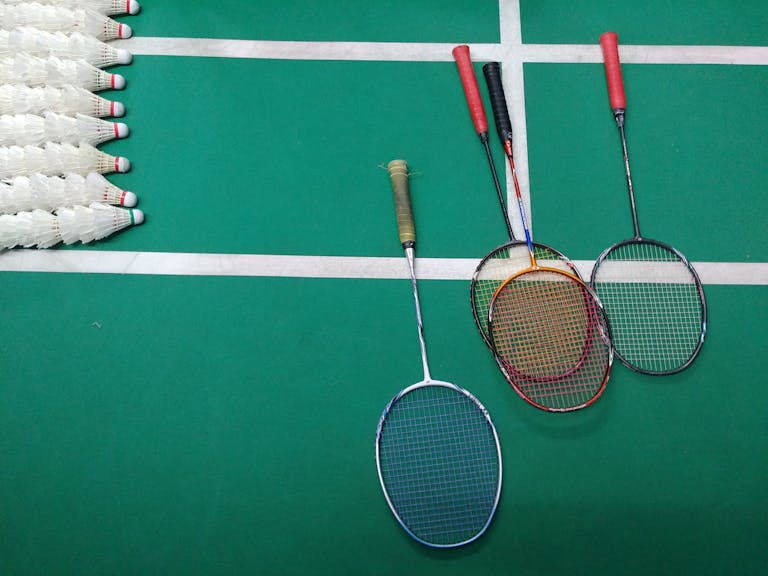Taufik Hidayat, an ex-Indonesian badminton player, was renowned for his quick and stylish footwork on court. He secured the men’s singles gold medal at the 2004 Athens Olympics and the All England title in 1999.
Active between the late 1990s and 2012, he was among the world’s premier singles players. Read on to discover more about his career and enduring influence.

The Prodigy
Taufik Hidayat’s narrative begins with youth and consistent development, as he ascended from prodigy to local hero to international contender, winning gold medals and competing in elite badminton tournaments that shaped his journey.
Early Start
Taufik had grabbed a racquet as a kid, attracted to the fast-paced, skillful nature of the game. He trained at a local club, where coaches soon recognised his instinct for the game. He practiced hard, regularly putting in hours at the court, honing footwork and form.
- His dad, a badminton player, gave him his initial lessons.
- Local club coaches, who drove him to compete and hone his fundamentals.
- It was watching local tournaments that made him dream of bigger stages.
- Support from friends who played with him after school.
Taufik excelled in junior tournaments, capturing national titles before he was 15. By his mid-teens he had been selected for the national team, a huge step in Indonesia. His family sacrificed, frequently on the road with him or assisting with gear and expenses.
Coaches offered him hard love, nudging him to continue learning and maintain focus. These early wins constructed his skills and provided him with the confidence to turn professional.
National Hero
Taufik’s victories, including his remarkable 2004 Athens gold medal, made him a household name in Indonesia. His fluidity and daring on the court in elite badminton tournaments endeared him to fans. This gold medal not only earned him respect but also showcased that Indonesia could be a world sports leader, especially in badminton. Following his success, clubs experienced increased enrollment, and Taufik frequently addressed youth gatherings to motivate aspiring athletes.
His 2004 Athens gold medal returned a new respect for badminton back home. The victory made news, and they saw him as evidence that Indonesia could be a world sports leader. Clubs experienced increased enrollment, and Taufik frequently addressed youth gatherings to motivate them.
He received multiple national awards such as the Satya Lencana award by the government, and other accolades by sports organizations. These demonstrated not only the impact he had on the nation, but how he motivated aspiring athletes to pursue their passion.
Rivalries Forged
Rivalries became a prominent aspect of Taufik’s career. He went up against China’s Lin Dan frequently, and their bouts attracted large audiences. He had hard games with Shon Seung-mo, of South Korea, each forcing him to perform at a higher level.
Facing elite competition pushed him to work harder and be innovative in his preparation. Their matches were quick, packed with cunning strokes and intelligent strategies. These matches established his reputation as a world-class player.
- 2004 Olympic final against Shon Seung-mo: Taufik’s win in straight sets was a career highlight, showing his nerve on the biggest stage.
- 2006 Asian Games final against Lin Dan: Taufik’s victory in a tense match set the tone for one of badminton’s best rivalries.
- Thomas Cup battles with Lin Dan: Their team matches drew global attention and pushed both players to the limit.
Taufik even respected his opponents in hard fought matches. He would frequently shake hands and trade small words post-match, indicating that for him, sport was about more than just winning.
Career Milestones
Taufik Hidayat’s remarkable career left an indelible imprint on world badminton, with a series of accomplishments that defined not only his legacy but the evolution of the sport in Indonesia. His journey from a young prodigy to a global icon inspired many, as shown in the table below:
| Year | Event | Achievement |
|---|---|---|
| 1997 | Asian Junior Championship | Gold Medal |
| 1998 | Asian Games | Gold Medal |
| 1998 | Asian Championship | Bronze Medal |
| 1999-2006 | Indonesia Open | 6 Titles (except 2005) |
| 2004 | Athens Olympics | Gold Medal (Men’s Singles) |
| 2005 | World Championships | Gold Medal |
| 2006 | World Championships | Smash Speed Record (305 km/h) |
These milestones didn’t just build his reputation — they helped raise Indonesia’s profile in global badminton. His victories gave the sport greater visibility, inspiring youth players and stoking regional enthusiasm for badminton tournaments.
Every tournament he dominated became a display of talent and ambition.
1. Olympic Gold
Taufik Hidayat’s march to 2004 Olympic gold was a signature race in his career. He had entered Pelatnas Cipayung as a teenager, but it was Athens where he found his ultimate test.
In the final he met South Korea’s new power, Shon Seung-mo. It was a hard-fought match; Hidayat’s cool and precise play was decisive. Taking Olympic gold had landed him in a distinguished club of champions and was a glorious moment for Indonesia.
The triumph sent a pride through his country and represented a watershed in his own legacy.
2. World Champion
Taufik Hidayat was to face one tough opponent in 2005 at the World Championships in Lin Dan. He earned the championship with talent and concentration, yet another magnificent achievement to his name.
Not only did world champion status cement his position as one of the best, it increased his value to international badminton. The victory arrived following a season of battling through injuries and hard fought tennis, reflecting his determination.
Fans and players alike applauded his game, viewing him as a prototype for the emerging generation of players.
3. Asian Dominance
Hidayat’s supremacy in Asia is evident from his numerous Asian Games medals and other regional competitions. Taking gold at the 1998 Asian Games, he never stopped winning in the years that followed, cementing his dominance in the region.
These wins elevated Indonesia’s status in Asian badminton. His games in these matches used to pull big crowds and inject excitement into the sport.
Arguably, my favorite moments were his nail-biting teenage victory that marked the beginning of his reign.
4. Indonesia Open
He captured six Indonesia Open titles from 1999 to 2006. This tournament is special to local fans, and his repeated wins there only intensified his connection with the crowd.
The atmosphere in the stadium whenever he played was second to none. Fans witnessed his talent in clutch moments, his gritty comeback victories. Dominating so frequently on our turf made him a folk hero.
Year after year, he showed up strong. No other Indonesian singles player has matched this feat.
5. Pivotal Wins
Others turned around the trajectory of Hidayat’s career. His victory at the 1997 Asian Junior championship had been a harbinger.
He focused on speed, footwork, and mental strength, employing clever strategies to outsmart his top competitors. These victories increased his confidence, priming him for more significant trophies.
Each key match assisted him in constructing a style grounded in technique and patience. These moments shaped his mindset for big tournaments.
They had him striving for more throughout his 17-year career.
Signature Style
Taufik Hidayat’s style redefined how we watch badminton tournaments. His combination of power and grace dotted every game, allowing him to win gold medals with ease. He could pound with power, but he stepped lightly, showcasing his smooth footwork and the ability to turn attack into defense in an instant. Even today, both fans and players still rave about his skills, particularly his backhand and netplay, which set new benchmarks for the game.
The Backhand
His backhand was not just a shot. They were weapons. Few could match the speed, control and reach he displayed with it. In pressure points, Taufik trusted his backhand to transform defense into offense. There, he pounded sharp cross-court winners or deep clears that had opponents scattering.
Years of focused training, to be sure, helped get me there. Every day, he pounded away at wrist strength, footwork, and timing. This made his backhand both forceful and accurate. His opponents would frequently attempt to push him onto his backhand, assuming it a vulnerability, and he transformed it into a menace.
In matches such as the 2004 Olympic final, these backhands were crucial.
Deceptive Netplay
At the net, Taufik fooled his rivals with crafty moves. He could pretend to attack a drop shot, then whip the shuttle far. This kept his opponents guessing and opened the court for him. Take, for instance, his facing Peter Gade in the 2005 World Championships, where net deception secured critical points.

This netplay wasn’t simply for the sake of illustrating an example. It made defenders shift and respond, exhausting them. Net control is a huge factor in elite badminton. If you can hold serve, you dictate the rhythm of the rally and compel your opponent to play your style.
Court Presence
Taufik towered and serene, unafraid. His body language signaled competitors he ran the show. This stance unsettled a lot of people. Even if the game was a nailbiter, he remained composed. Mental toughness allowed him to rebound from hard jams and concentrate under pressure.
He commanded respect from fans and foes alike. They admired his grace and pressure management. To a lot of people, just having him there made matches seem larger.
Influence Checklist
- Merged speed, power and touch in a single style, redefining the bar for subsequent players.
- Popularized the use of strong backhand clears and smashes.
- Demonstrated the importance of clever, tricky net shots during a match.
- Proved that mental strength and confidence can change outcomes.
- Motivated thousands to condition for ability, not brawn.
Backhand Smash
The backhand smash was Taufik Hidayat’s signature shot. In men’s singles, where quickness and accuracy make the difference in matches, his backhand smash became known for its power and its unpredictability. Few players attack with the backhand; Taufik’s forehand gave him a special advantage.
His trademark backhand smashed at full power from anywhere on the court kept opponents off balance, readjusting their positioning and defensive strategy. Not just a shot, but a statement of skill that distinguished him in world badminton.
Unmatched Speed
Few could match the sheer speed of Taufik’s backhand smash, a skill that contributed to his success in elite badminton tournaments. At the 2006 World Championships, one of his backhand smashes was measured at in excess of 200 km/h – a speed practically unheard of for this stroke. Some of the best singles players find it difficult to get both the angle and the speed on the backhand, but Taufik shattered this stereotype, showcasing his talent on the world stage.
He frequently deployed this speed to disrupt rally rhythm in big matches, transforming defensive stances into instant offense. When games got tight, his speed allowed him to catch opponents off-guard, giving him the initiative at crucial moments. This ability to win crucial points was essential in his journey to claim multiple gold medals.
The speed and placement of these shots rendered others indecisive and unable to reply with good returns. International tournament statistics underline how seldom competitors could predict or get to his backhand.
Actually, even quick reflex players such as Lin Dan or Peter Gade were surprised by the velocity. This weapon served as a psychological and tactical advantage, rendering opponents gun-shy about hitting to Henry’s backhand at all.
Technical Breakdown
The mechanics behind Taufik’s backhand smash begin with his loose grip, which allowed him to generate snap from the wrist and forearm. A rapid recalibration of his feet positioned the body for the shot, and the swing timing allowed him to strike the shuttle late without sacrificing speed.
Grip, footwork, and razor timing all contributed. His grip provided last-second alterations, his footwork set him behind the shuttle swift. Timing was everything. He hit the shuttle at the highest point, which kept his smashes flat and difficult to anticipate.
Up and coming players analyze his form to understand how to inject pace without flailing. Taufik’s backhand developed with age, becoming slicker and less brute force and an example of how technique can trump youth.
Tactical Use
Taufik chose his moments to backhand smash. He waited until his opponent played a weak lift to his backhand, then blazed forward. In tight matches, this shot allowed him to finish points swiftly or induce soft returns.
A well-known instance of this was the 2005 World Championships final, during which he deployed the backhand smash to shatter his opponent’s defense during a critical game. His opponents would duck his backhand, but this left other areas of the court exposed to him.
Opponents attempted to respond by shoving shuttles wide or deep to his forehand, but this occasionally backfired, enabling him to take control of rallies. It was this tactical flexibility that gave Taufik an edge, particularly under pressure.
Admiration from Fans and Players
Fans would watch backhand smashes replays in awe. Countless top players have declared it the greatest ever. Coaches use his technique as a teaching model worldwide.
His backhand smash inspired a new generation of players.
The Maverick
Taufik Hidayat’s career is defined by a signature style — not just in terms of technique, but a strong voice and a maverick approach. His decisions, both on and off the badminton tournaments, distinguished him from contemporaries and crafted public perception of him as a competitor and future rival.
Unfiltered Opinions
Taufik was never shy about expressing his opinions, especially regarding the challenges of elite badminton tournaments. He was candid about how difficult the sport is, discussing sportsmanship and what he perceived to be issues with the rules or match judging. Sometimes he questioned calls by refs or emphasized how prize money ought to be more even for players, particularly in prestigious events like the world championships.
To fans and other players he was a breath of fresh air, an outspoken adversarial spirit who didn’t keep his opinions under wraps for fear of causing offense. His candor occasionally stirred controversy — particularly when he opined on the governance of badminton or what the sport might do more of for players post-retirement.
In multiple interviews he highlighted issues such as insufficient player backing or cast doubt on how certain nations constructed their squads. Some of them agreed with him, others considered him too harsh. His vocal nature helped catalyze discussions that may not have taken place otherwise.
Over time, this provided people with fresh perspectives on badminton—not just as a sport, but as a platform where candid conversation could spark transformation, influencing the future of competitions like the Asian Championships and the Olympic Games.
Career Challenges
Taufik’s career wasn’t a smooth one. He had to battle through injuries, such as issues with his shoulder and back, which occasionally sidelined him for months at a time. He had the added burden of triumphing for his nation, and with each title he captured, the world wanted more.
Some years he lost early in big tournaments or was dogged by his form, which challenged his confidence. His approach to adversity was to persist. He switched coaches, experimented with novel training strategies, and discovered how to rest.
Even when most had written him off, he never stopped finding ways to prove them wrong—like pulling off an Olympic gold win in 2004 after a difficult slump. These moments established a hard-nosed toughness brand and demonstrated to younger players that a failure isn’t always disastrous.
To many he was the testament that grit and self-trust count as much as skill.
Off-Court Ventures
After retiring from the top level of competition, Taufik didn’t abandon the sport. He founded the Taufik Hidayat Arena – a training center with courts and classes for all ages – in Jakarta. It’s a space where young players absorb not only skills, but such principles like hard work and sportsmanship.
He has participated in numerous initiatives to provide badminton fundamentals across Indonesia. He serves as a mentor, passing along guidance to the upcoming cohort of players. Between them, he has helped the sport’s standing and given back to a game that molded him.
Lasting Legacy
Taufik Hidayat’s badminton legacy is as rich as it is extensive. His style, wins and sportsmanship defined new standards, influencing both Indonesian culture and the world’s perception of the sport.
The table below breaks down key elements of his legacy:
| Element | Details |
|---|---|
| Sporting Success | Olympic gold medalist (2004), World Champion (2005), multiple All England finalist |
| Technique | Known for powerful backhand, deceptive drop shots, unique footwork |
| Inspiration | Motivated many young players in Indonesia and abroad |
| Recognition | Considered among Indonesia’s greatest athletes; frequent honoree at national sports events |
| Cultural Impact | Iconic figure in Indonesian sports, pushes badminton’s popularity in Indonesia |
| Post-Retirement | Runs badminton academy, promotes grassroots sports, mentors future stars |
Modern Influence
Taufik Hidayat’s game influenced today’s players. His signature backhand smash is now an exemplar. Players such as Kento Momota and Viktor Axelsen cite Taufik’s shot-making as a major inspiration.
His combination of pace and precision revolutionized how we train for singles. Training camps now dissect his footwork and grip shifts to instruct rookies. Video of his matches are put in lessons, teaching students how to remain calm under pressure and use rapid-fire net play.
Some clubs across the globe still employ portions of his drills emphasizing agility and timing. Young athletes, even beyond Indonesia, admire his sportsmanship and big victories. After his 2004 Olympic gold, kids across Asia and Europe started playing badminton–hanging to mimic his style.
His silky play and confidence in close games continue to show up in the way contemporary players attack nail-biters. His impact is as much in the manner the game is played as it is in the way athletes conduct themselves on and off of the court.
Post-Retirement
Upon exiting the big stage, Taufik didn’t walk away from the sport. He founded the Taufik Hidayat Arena in Jakarta, a training center for junior players. The center holds clinics, tournaments and open practices, allowing kids from all walks to give the sport a shot.
He goes to schools and little clubs to sell badminton, places where they lack money. He talks of comradeship, honor, and the importance of discipline. His hands-on work at the grassroots level has expanded the sport’s reach, attracting youth who may not have had the opportunity otherwise.
He collaborates with Indonesia’s sports board, lending his voice to policies that benefit both pro and new athletes. His guidance informs coaching standards and athlete care programs. Many regard him as a lifelong mentor, demonstrating that being a champion isn’t just about triumph, but about paying it forward.
Global Impact
Taufik’s wins on the world stage, including his impressive singles gold medals, extended badminton’s profile beyond Asia. He was the beating heart of the Thomas Cup, the All England, and the Asian championship. Every time he took to the field, he showcased the game’s pace and flair to fresh followers, particularly during elite badminton tournaments.
His 2004 Olympic success, where he competed in the singles competition, highlighted Indonesian badminton on the world stage. Following that, countries worldwide began to view badminton as a competitive sport rather than a hobby. Tournaments across Europe and the Americas started attracting increased attendance, partially due to his star status.

He talked a lot about respect among players from all countries. His grace and understated style made him a superstar at international competitions. Numerous fans and players report his legacy inspired them to view badminton as an international community, rather than a sport.
His story still inspires badminton enthusiasts, coaches, and players globally.
Final Thoughts
Taufik Hidayat displayed skill, panache and toughness on every court. Fans recall his nimble footwork, rapid-fire hands and ferocious backhand smashes. He was striking for daring moves and a new style of play. In big matches, Taufik kept his cool and attacked. Even today, many young players still look up to him, hoping to pick up his moves and mindset.
His narrative resonates as authentic, beyond statistics or victories. Taufik’s name evokes conversations of clever shots, hard dedication and passion for badminton. For more on his strategy or to follow tennis legends, visit reliable tennis news or dynamic tennis forums. Stay hungry, and play it your way.
Frequently Asked Questions
Who is Taufik Hidayat?
What about Taufik Hidayat, the phenomenal badminton player from Indonesia? He is globally renowned for his powerful playing style and signature forehand jump smash.
What are Taufik Hidayat’s major career milestones?
Taufik Hidayat clinched the men’s singles gold medals at the 2004 Olympic Games and 2005 World Championship, adding to his impressive record in elite badminton tournaments.
What makes Taufik Hidayat’s playing style unique?
Taufik Hidayat was known for his silky footwork and deceptive shots, which helped him win gold medals in elite badminton tournaments, showcasing his mental toughness.
Why is Taufik Hidayat’s backhand smash famous?
His backhand smash is notable for its power and precision, much like the forehand jump smash used by elite badminton tournaments players. Very few can duplicate this shot — it’s what makes his game so spectacular.
How has Taufik Hidayat influenced badminton globally?
Taufik Hidayat fired the imagination of a new generation. His techniques studied and revered by coaches and athletes around the world.
What does Taufik Hidayat do after retiring from professional badminton?
Since retiring, Hidayat has dedicated himself to coaching at a badminton training center, advancing badminton through sports academies for young players.
What is Taufik Hidayat’s legacy in sports?
Remembering badminton maverick, Taufik Hidayat, his legacy is more than just gold medals; it’s his impact on the sport’s style and the players he inspired in elite badminton tournaments.






